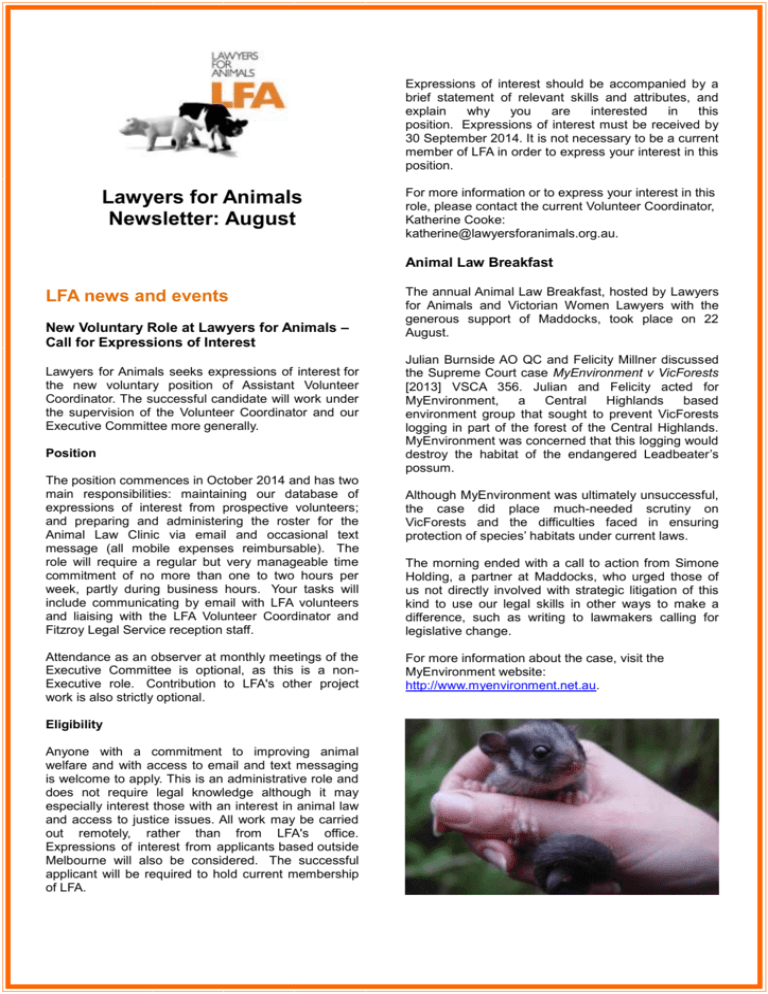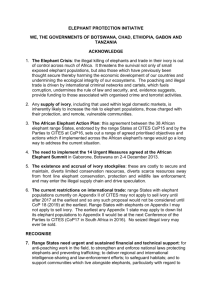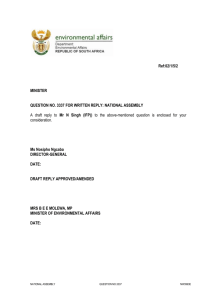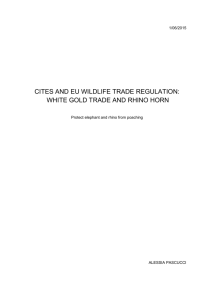LFA Newsletter – August
advertisement

Expressions of interest should be accompanied by a brief statement of relevant skills and attributes, and explain why you are interested in this position. Expressions of interest must be received by 30 September 2014. It is not necessary to be a current member of LFA in order to express your interest in this position. Lawyers for Animals Newsletter: August For more information or to express your interest in this role, please contact the current Volunteer Coordinator, Katherine Cooke: katherine@lawyersforanimals.org.au. Animal Law Breakfast LFA news and events New Voluntary Role at Lawyers for Animals – Call for Expressions of Interest Lawyers for Animals seeks expressions of interest for the new voluntary position of Assistant Volunteer Coordinator. The successful candidate will work under the supervision of the Volunteer Coordinator and our Executive Committee more generally. Position The position commences in October 2014 and has two main responsibilities: maintaining our database of expressions of interest from prospective volunteers; and preparing and administering the roster for the Animal Law Clinic via email and occasional text message (all mobile expenses reimbursable). The role will require a regular but very manageable time commitment of no more than one to two hours per week, partly during business hours. Your tasks will include communicating by email with LFA volunteers and liaising with the LFA Volunteer Coordinator and Fitzroy Legal Service reception staff. Attendance as an observer at monthly meetings of the Executive Committee is optional, as this is a nonExecutive role. Contribution to LFA's other project work is also strictly optional. Eligibility Anyone with a commitment to improving animal welfare and with access to email and text messaging is welcome to apply. This is an administrative role and does not require legal knowledge although it may especially interest those with an interest in animal law and access to justice issues. All work may be carried out remotely, rather than from LFA's office. Expressions of interest from applicants based outside Melbourne will also be considered. The successful applicant will be required to hold current membership of LFA. The annual Animal Law Breakfast, hosted by Lawyers for Animals and Victorian Women Lawyers with the generous support of Maddocks, took place on 22 August. Julian Burnside AO QC and Felicity Millner discussed the Supreme Court case MyEnvironment v VicForests [2013] VSCA 356. Julian and Felicity acted for MyEnvironment, a Central Highlands based environment group that sought to prevent VicForests logging in part of the forest of the Central Highlands. MyEnvironment was concerned that this logging would destroy the habitat of the endangered Leadbeater’s possum. Although MyEnvironment was ultimately unsuccessful, the case did place much-needed scrutiny on VicForests and the difficulties faced in ensuring protection of species’ habitats under current laws. The morning ended with a call to action from Simone Holding, a partner at Maddocks, who urged those of us not directly involved with strategic litigation of this kind to use our legal skills in other ways to make a difference, such as writing to lawmakers calling for legislative change. For more information about the case, visit the MyEnvironment website: http://www.myenvironment.net.au. Other events Invitation to Comment – Proposal to Take Stricter Domestic Measures to Regulate the Import and Export of Specimens of African Lion The Australian Government is calling for submissions on the regulation of African lions under the Convention on International Trade in Endangered Species of Wild Fauna and Flora (“CITES”). Specifically, the Government is considering listing African lions under a different Appendix in CITES, which would make it more difficult for people to trade lion products, particularly in the form of hunting trophies. The following information is taken from the Federal Department of Environment’s website: The Australian Government is considering a proposal to treat specimens of African lion as though they are listed on Appendix I of the Convention on International Trade in Endangered Species of Wild Fauna and Flora (CITES), which will affect the regulation of the import and export of lion specimens, including hunting trophies. Species are listed under CITES based on how threatened they have become through trade: CITES Appendix I includes species that are currently threatened with extinction (trade can only occur in limited circumstances i.e. conservation breeding, vintage specimens), CITES Appendix II includes species that are not threatened with extinction now but could become so if trade is not regulated. Trade in Appendix II species requires a CITES permit, issued only where it can be scientifically proven that trade is sustainable, and CITES Appendix III includes species that are threatened only in one country (trade requires CITES permits or certificates). Lions are currently listed on Appendix II of CITES and are protected under Australia’s national environmental law, the Environment Protection and Biodiversity Conservation Act 1999 (the EPBC Act). International trade in any lion specimen is regulated under this legislation. The proposal to introduce a stricter domestic measure for trade in African lions is in response to concerns about trade in lion specimens, including hunting trophies. If introduced, the proposal would restrict trade in lion specimens to those specimens that meet one of the following criteria: the specimen was obtained prior to the listing of African lion on CITES; the specimen is being traded as part of an exchange of scientific specimens or for research purposes; or as part of a Cooperative Conservation Breeding Program (for live specimens). Lion trophies could only be traded if they could be proven to be preConvention specimens (specimens obtained prior to 1976). The proposal to further regulate trade in lion specimens may have implications for businesses involved in wildlife trade and tourism, other industries and individuals. You are invited to submit information to help the Department identify the potential impacts of treating the African lion as an Appendix I species under Australian legislation. Please provide your written comments by AEST 5pm 22 September 2014 to: The Director Wildlife Trade Regulation Department of the Environment GPO Box 787 CANBERRA ACT 2601 wildlifetrade@environment.gov.au For the Love of Wildlife, an Australian grass roots nonprofit organisation, has been working to get the Australian Government to take a stand against the industry of canned hunting by tightening legislation around the importation of hunted animal trophies into Australia. Visit www.fortheloveofwildlife.org.au for further information. LFA Article The Protection of Elephants under International Law: CITES and the Ivory Trade By Fei Wu, LFA Volunteer Introduction Alternatively called ‘white gold’, ‘organic gemstones’, or ‘bloody teeth’, ivory from elephant tusks has become the latest conflict resource in Africa. A burgeoning appetite in Asian marketplaces is fuelling demand for ivory that is being met by increasingly sophisticated and ruthless criminal syndicates and armed militia. In 2013, over 20,000 elephants are reported to have been unlawfully killed in Africa, 1 part of a worrying trend which is threatening the survival of elephants and testing the strength of international protection of these endangered species. What is CITES? At the international level, commercial trade in elephant tusks is prohibited under the Convention on International Trade in Endangered Species of Wild Fauna and Flora (“CITES”). Currently, 180 States are party to the convention, including China, Thailand, Vietnam and most of the countries in Africa. CITES is a multilateral treaty with the goal of regulating international trade in wildlife so that the trade does not jeopardise survival of wild animals. CITES seeks to achieve this goal by offering varying degrees of protection to over 35,000 species of animals and plants listed in its three Appendices: 1. Appendix I offers the highest level of protection. It lists ‘all species threatened with extinction which are or may be affected by trade’.2 Accordingly, international trade in these animals is totally prohibited except where the trade is for a non-commercial purpose such a scientific research. Comprised of approximately 3% of species listed under CITES, Appendix I animals include tigers, giant pandas, orang-utans and both Asian and African elephants. 2. Appendix II lists wildlife such as hippopotamuses and certain types of orchids that are not yet at risk of extinction but which could be threatened by unlimited trade. Appendix II also includes species that look closely enough like others already on the list to promote conservation of the already-listed species. Commercial trade in Appendix II listed species is allowed when conditions are satisfied, such as when a ‘Scientific Authority of the State of export has advised that such export will not be detrimental to the survival of that species’.3 Approximately 96% of the wildlife species listed are protected under Appendix II. 3. Appendix III of CITES lists species that are only protected under national laws of a State party and the State has requested cooperation from other States to aid in conserving those species. Commercial trade in these species must not contravene national laws and requires the presentation of export permits and certificates of origin. The wildlife listed in Appendix III comprises only around 1% of the species listed in CITES. Examples include the four-horned antelope (protected in Nepal), the golden jackal (protected in India) and the double-striped thick-knee bird (protected in Guatemala). The Ivory Crisis In the 1980s, widespread poaching wiped out almost half of Africa’s elephant population, 4 which prompted African elephants to be added to Appendix I of CITES. This effected a global ban on sales of ivory and elephant numbers slowly recovered. But then individual African countries (among them Zimbabwe, led by Robert Mugabe) started disobeying the ban. This then led to some legal ‘one-off’ sales of ivory by Zimbabwe, Botswana and Namibia in 1999 and then 2002. In 2008, CITES gave in to aggressive lobbying by China and sanctioned another ‘one-off’ sale of 102 tonnes of stockpiled ivory to Chinese and Japanese traders. This controversial sale raised US$15.4 million for local African communities and elephant conservation.5 Supporters of the sale hoped that an influx of cheap, legal ivory would save elephants by undercutting the illegal trade, while opponents warned that it would revive the market. The opponents were right. Camouflaged by a flurry of legal ivory transactions, the black market for ivory flourished. Since 2008, ivory 3 Convention on International Trade in Endangered Species of Wild Fauna and Flora, Article IV, paragraph 2(a). 4 ‘Tackling the Ivories, The Status of the US Trade in 1 Report of the CITES secretariat. Elephant and Hippo Ivory’, TRAFFIC North America, World Wildlife Fund, September 2004. 2 Convention on International Trade in Endangered Species 5 ‘Ivory auctions raise 15 million USD for elephant of Wild Fauna and Flora, Article II, paragraph 1. conservation’, CITES Press Release, 7 November 2008. prices (and elephant casualties) have climbed steeply. In June 2014, the CITES Secretariat published a report stating that poaching has risen back to unsustainable levels, with over 20,000 African elephants poached in 2013.6 The report also shows a marked increase in seizures of large ivory shipments of over 500kg, which suggests the involvement of transnational organised crime.7 Wildlife trafficking is a lucrative trade, particularly in tumultuous and impoverished nations. Estimated to have a value of up to US$20 billion annually, 8 it is characterised as a high-profit, low-risk crime. Illicit trade in ivory, in particular, is facilitated by political unrest, porous borders and corrupt officials. Notorious extremist militia groups such as the Lord’s Resistance Army and the Janjaweed are said to use elephant poaching and ivory trafficking to sustain their other crimes. A large proportion of this ivory is smuggled into Asia, where prices are soaring and one pair of tusks can be worth more than 10 times the average annual income in many African countries.9 Is CITES protecting the elephants? It has not escaped the notice of the CITES Standing Committee that, despite being afforded maximum protection under its Appendix I, elephants are still being systematically slaughtered across Africa. In March 2012, at the 16th meeting of the Conference of the Parties of CITES (CoP16) in Bangkok, eight countries from Africa to Asia were identified as having significant involvement in global ivory trafficking: Kenya, Tanzania and Uganda as source and exit points in Africa; Malaysia, Philippines and Vietnam as transit countries; and most importantly, China and Thailand as the end-use markets which are driving the demand for ivory. Each of these countries were required by CITES to develop action plans demonstrating how they intend to stem the flow of banned ivory. illegal under CITES.11 This report was published days before the next intercessional meeting of the CITES Standing Committee. Unsurprisingly, Thailand’s lack of progress was heavily criticised by the CITES Standing Committee. The meeting concluded with Thailand being given an onerous timetable of actions to be completed to curb the illicit ivory trade, this time backed with the threat of trade sanctions. It was decided that if Thailand had not made sufficient advances in this regard, members of the CITES Standing Committee would vote on whether punitive trade sanctions should be imposed against Thailand, depriving the country of its lucrative orchid and exotic wood exports. These actions have been widely welcomed by the media and conservation groups such as the World Wildlife Fund. Thailand’s failure to meet its CITES obligations and its public rebuke from CITES, however, has diverted attention from China’s inaction. As the other country identified in CoP16 as an end-market for trafficked ivory, it is said that China’s vast and proliferating middle class is the biggest driver of demand for ivory.12 As one of the fastest growing economies in the world, China’s GDP is well over 20 times that of Thailand. Whilst this means China is not as vulnerable to sanctions such as those facing Thailand, it also means that China is much better placed to make a real impact. It will be necessary, therefore, for CITES to exert pressure on China to put an end to its substantial part in this illicit trade. The alternative is the gradual decimation of the elephant population and the inestimable consequences of living in a world with no more elephants (but littered with bits of elephant teeth). Despite the chastisements and the action plans of CoP16, an undercover survey conducted in Bangkok showed that the ivory market had roughly doubled in size10 from January 2013 to May 2014 and concludes that the vast majority of the ivory sold in Thailand is 6 ‘Elephant Conservation, Illegal Killing and Ivory Trade’, Lawyers for Animals CITES, Sixty-fifth meeting of the Standing Committee Geneva (Switzerland), 7-11 July 2014. 7 Elephant poaching and ivory smuggling figures released today, CITES Press Release, 13 June 2014. 8 http://www.nytimes.com/2012/09/04/world/africa/africas- REG NO A0047I00G ABN 74 557 651 569 elephants-are-being-slaughtered-in-poachingfrenzy.html?ref=ivory. 9 http://www.nytimes.com/2012/09/04/world/africa/africas- elephants-are-being-slaughtered-in-poachingfrenzy.html?ref=ivory. 11 ‘Polishing off the ivory: Surveys of Thailand’s ivory 10 The number of worked ivory products found for sale rose market’, TRAFFIC, World Wildlife Fund, 2 July 2014. from 5,865 and the number of ivory retail outlets rose from 61 to 105. 12 ‘From Elephants’ Mouths, an Illicit Trail to China’, New York Times, 1 March 2013.







